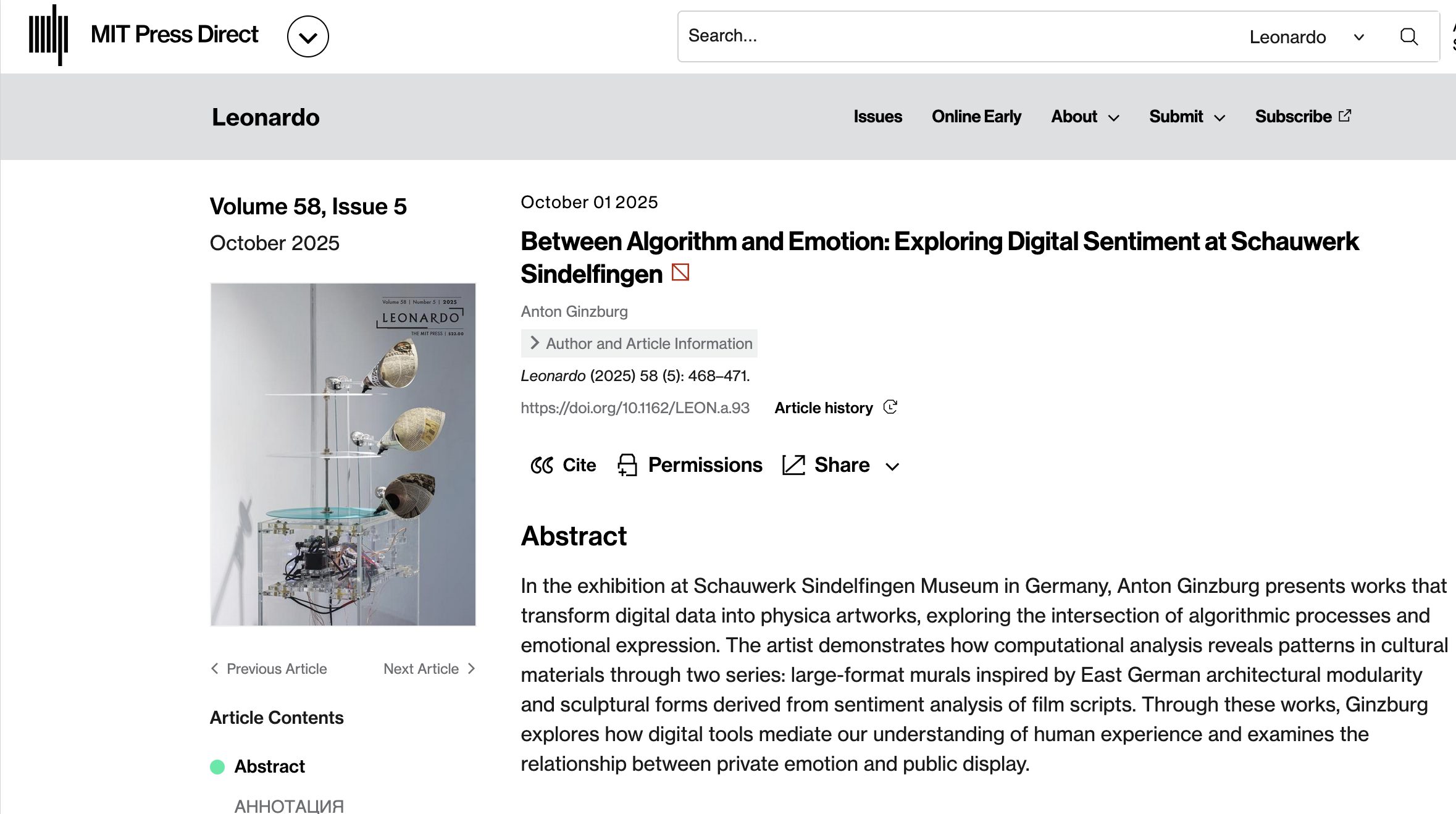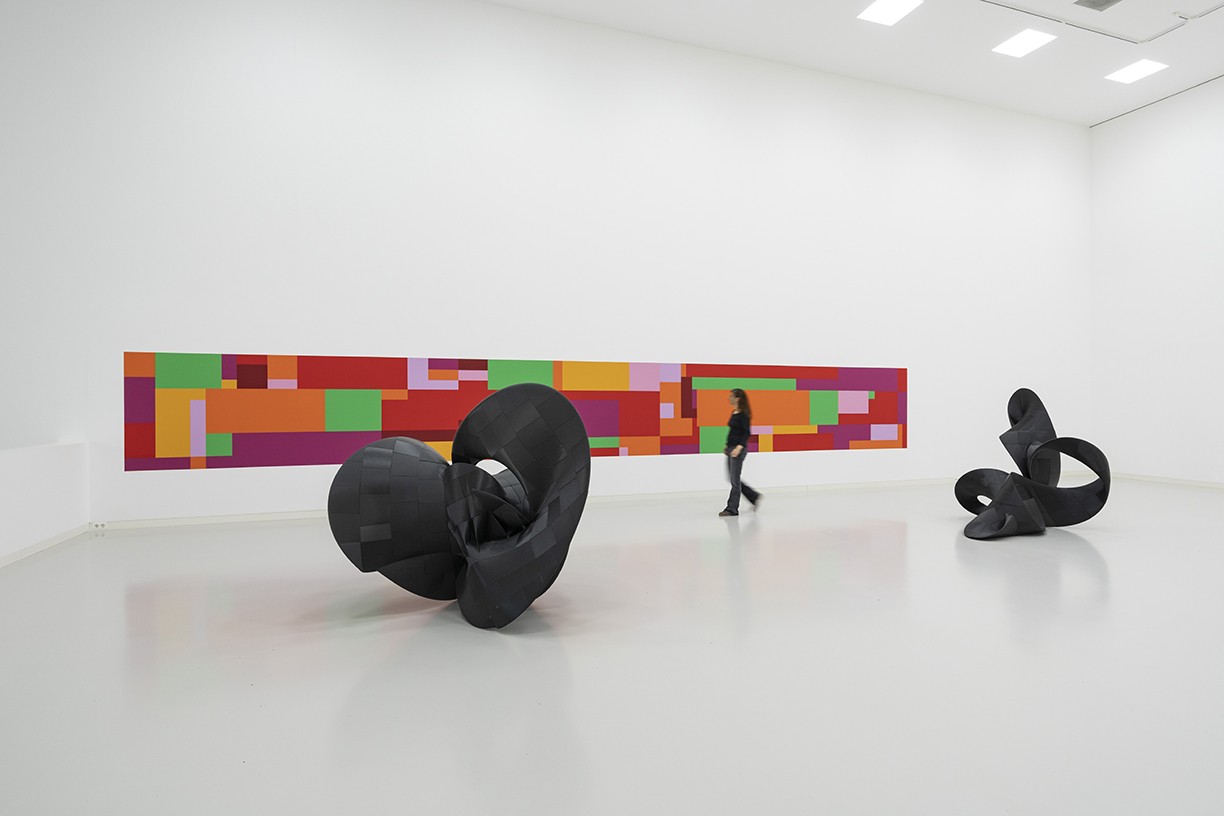
https://direct.mit.edu/leon/article-abstract/58/5/468/131961/Between-Algorithm-and-Emotion-Exploring-Digital?redirectedFrom=fulltext

Abstract
In the exhibition at Schauwerk Sindelfingen Museum in Germany, Anton Ginzburg presents works that transform digital data into physical artworks, exploring the intersection of algorithmic processes and emotional expression. The artist demonstrates how computational analysis reveals patterns in cultural materials through two series: large-format murals inspired by East German architectural modularity and sculptural forms derived from sentiment analysis of film scripts. Through these works, Ginzburg explores how digital tools mediate our understanding of human experience and examines the relationship between private emotion and public display.
Between Algorithm and Emotion: Exploring Digital Sentiment at Schauwerk
My exhibition at Schauwerk Sindelfingen Museum in Germany (22 September 2024–27 April 2025) presents two bodies of work that transform digital data into physical artworks. Through computational analysis of field research, films, and texts, these artworks reveal emotional patterns in cultural materials and explore how digital tools shape our understanding of human experience.
My investigation began during a 2021 Schaufler Lab fellowship at the Technical University of Dresden, where I developed an algorithmic framework for generating geometric structures as a daily artistic practice. Each day, I created a watercolor composition in the same format, allowing algorithm-generated forms to interact with my responses to Dresden's architecture and atmosphere. Like diary entries, these works documented my dialogue with the city’s visual language, informed by research in the Mathematical Models Collection and Color Theory Collection at the TU Dresden Kustodie. The scientific precision of Harald Kueppers’ color-mixing machines in the Kustodie collection provided additional insights into color theory.
For the Schauwerk installation, I expanded these gouache studies into large-format murals (12 meters and 6.5 meters long) that engage with GDR architectural heritage, specifically the Formsteinsystem developed by Constructivist Dresden artists Karl-Heinz Adler (1927-2018) and Friedrich Kracht (1925-2007) in the late 1960s [1]. Their pioneering modular system for urban space design became a crucial reference for my algorithmic explorations. The resulting murals represent a contemporary interpretation of their systematic approach, bridging historical East German architectural modularity with current computational design methods.
The Film Forms spatial series transforms cinematic emotions into sculptural form through sentiment analysis — a digital tool typically used to track social media responses. Working with mathematician Maik Porrmann under Axel Voigt’s guidance, we created algorithms that translate film scripts’ emotional content into mathematical data. As Voigt explains [2], “The script is analyzed word by word and underlying sentiment, if positive or negative, is transformed to define the magnitude and direction of the vector.” Films like American Psycho (2000) and Trainspotting (1996) are transformed through this computational process into complex geometric surfaces. These surfaces are then developed into large-scale sculptures, 3D printed in carbon polyamide. The material’s black industrial surface emphasizes both works’ algorithmic complexity and interplay with light.
These works, from murals to sculptures, explore modernist modularity through contemporary technology. As artificial intelligence pioneer Marvin Minsky suggested, our “self” resembles building blocks—smaller parts working together as a modular system. This concept appears in both murals and sculptures, where individual elements combine into complex patterns. While this approach mirrors cinematic montage, it works within the constraints of 3D printing, turning technical limitations into aesthetic opportunities. Writing about this body of work in his essay Modularity as an Aesthetic Category, Lev Manovich notes the connection between formal and content modularity [3]: “The project transforms the most canonical modern modular media—i.e., cinema—into perfectly continuous forms. . . . The construction of a film from hundreds or thousands of shots is an example of how required technical modularity can become the content modularity.”
The work reveals a fundamental paradox between cinema and emotion. While films evoke feelings through artistic elements, quantifying these emotions through sentiment analysis transforms them into public data. Hannah Arendt’s analysis provides further insight [4]: Certain experiences lose their essence when made public, as “love. . . is killed, or rather extinguished, the moment it is displayed in public.” This becomes particularly relevant today, where algorithms constantly transform private experiences into public data.
The sculptures materialize this tension between private emotion and public display. Film emotions—already mediated—undergo a double transformation: first through algorithmic analysis, then through physical form. This process both reflects Arendt’s concern about authenticity in the public sphere and suggests new possibilities for emotional expression in our digital age.
The Schauwerk Sindelfingen exhibition examines how digital tools can transform scripted “cinematic emotions” into visual art. By combining algorithmic analysis with an artistic visual vocabulary of form, color, and space, these works explore the relationship between human feeling and its digital interpretation. The project suggests that in our increasingly technologically mediated world, new forms of emotional expression and understanding may emerge from the very tools we use to quantify and analyze our experiences.
…
1 Bozena Kowalska, Adler, Karl-Heinz: Auf der Suche nach Ordnung und Raum (Philo and Philo Fine Arts, 2004), 23.
2 Axel Voigt, “The Mathematics Behind ‘Film Forms’,” in Anton Ginzburg: Dresden Modular (Sandstein Verlag), 65.
3 Lev Manovich, “Modularity as an Aesthetic Category,” in Anton Ginzburg: Dresden Modular (Sandstein Verlag), 55.
4 Hannah Arendt, The Human Condition (University of Chicago Press, 1998), 51.


